A PREMIER COMMUNITY OF A RARE KIND
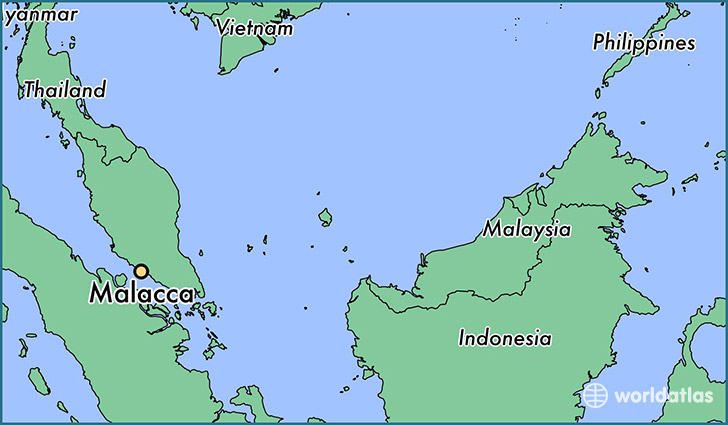
(Courtesy: https://www.worldatlas.com)
A PREMIER COMMUNITY OF A RARE KIND
This is a brief story of the community of the state of Malacca in Malaya / Malaysia, which was a dawning point for several first-time efforts for the Cause. The community’s unparalleled achievements have emblazoned the history of the Bahá’í Faith in Malaysia and deserves to be recorded for posterity.
The story centers around the communities of Malacca town and the other districts of Jasin, Alor Gajah and Alor Gajah’s sub-district, Masjid Tanah, which all fall within the state of Malacca. From the 1950s right through the early 1960s, the Bahá’ís of Malacca played an active part as champion-builders of the Cause in the then Malaya and subsequently Malaysia. While the Seremban, Kuala Lumpur and the Malacca Local Spiritual Assemblies were the first three to be established in this country, it was Malacca that led the way and undertook numerous first-time efforts in the early days with resounding success.
Malacca Town Community
Dr. K.M. Fozdar from India arrived as a pioneer in Singapore in 1950, and he was soon joined by his wife Mrs. Shirin Fozdar. Shirin Fozdar made tours of selected towns of Malaya in 1952 and 1953 to deliver public talks on the Faith. Following her tour of 1953, Yankee Leong of Seremban accepted the Faith as the first believer of Malaya. Soon he himself started traveling across the country teaching the Faith. He was instrumental in establishing the first Local Spiritual Assembly in Seremban in 1954. In that same year, the Faith started to take root in Malacca town. Mr. G. Saurajen, a teacher by profession and an early believer in Malacca and assisted Shirin Fozdar in organizing firesides in Malacca. In one such fireside in 1954, Mirinal Kanti Paul, Pijush Kanti Paul, and Tushar Kanti-Paul, three brothers from a Bengali ethnicity, became Bahá’ís. Among them, Tushar Kanti-Paul was the first youth in the country to sign a youth declaration card. These three were followed later by S. K. Somu, Leong Tat Chee, Chin Soon Boon, Chua Sin Eam, T. K. Kannan, Kumara Das, and Bhaskaran Sangaran Nair. Anthony Casimir Louis was the first Eurasian of Portuguese extraction in Malaya to accept the Faith, on Christmas eve of 1957.
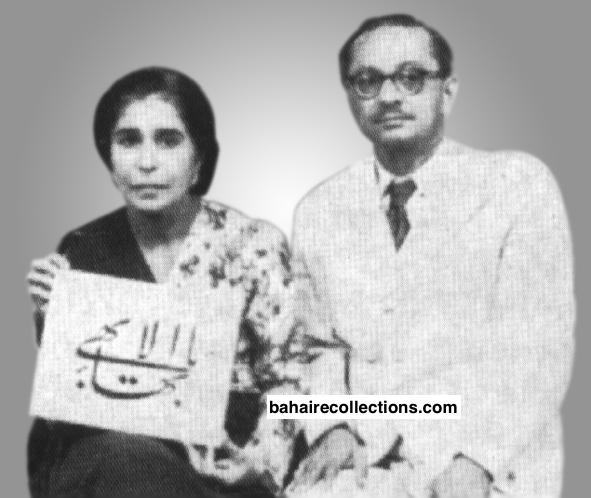
Mrs. Shirin Fozdar and Dr. K. M. Fozdar
In the following years, most of these early believers brought their families into the Faith which added to the strength of the community. Meanwhile, in 1955 a Local Spiritual Assembly was elected in Malacca town. This Assembly was registered in the same year under the Societies Ordinance 1949 and was exempted from paying income tax, thus becoming the first Local Spiritual Assembly to be given official recognition by the British colonial government of the time.
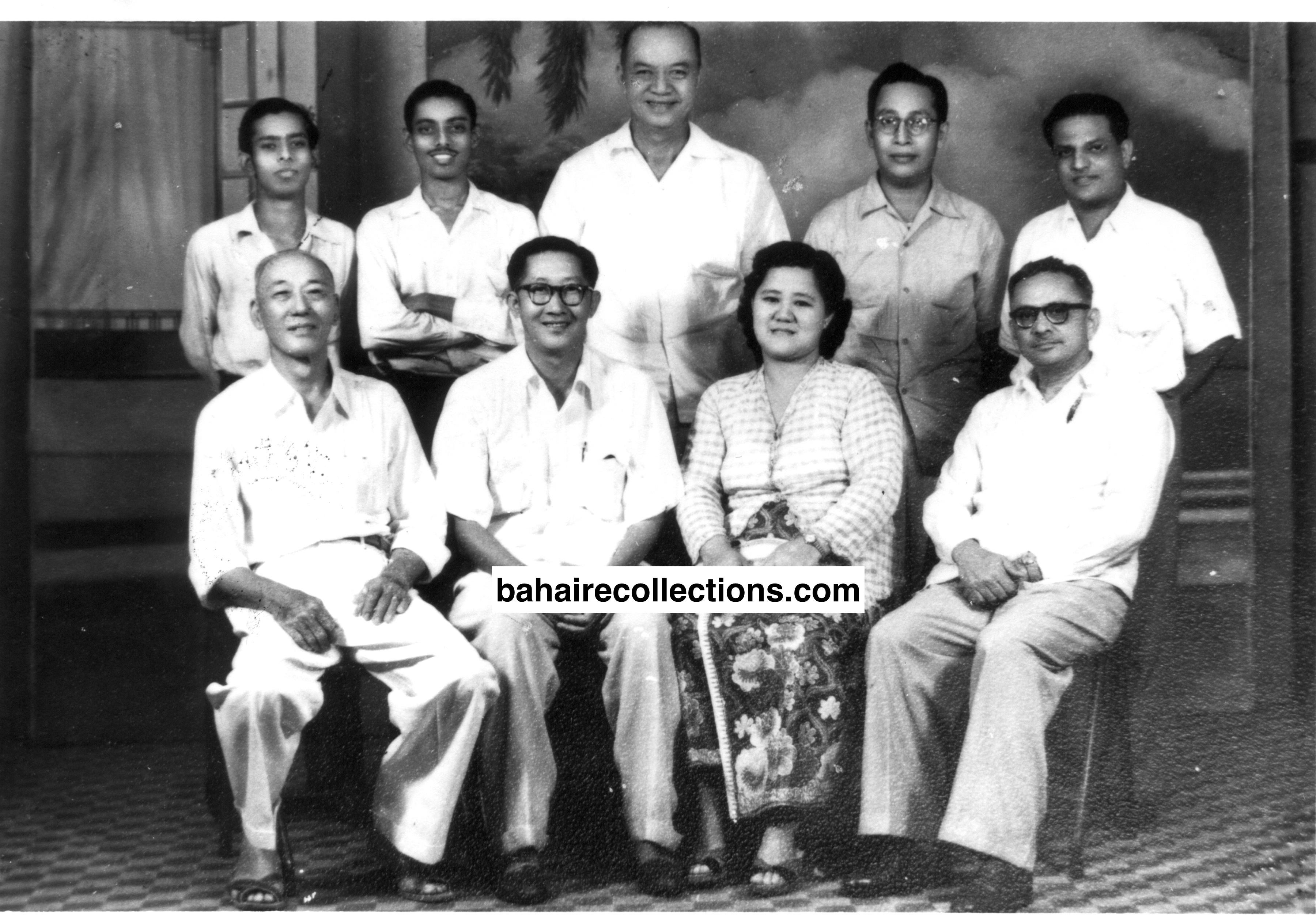
First Local Spiritual Assembly of Malacca Town. Standing (L-R) Mirinal Kanti Paul, Pijush Kanti Paul, Cheong Tiong Hak, Abdul Rasul G. Kass, G. Saurajen. Seated (L-R) Ho Eng Wah, Leong Tat Chee, Mrs. Lena Saurajen, Dr. K. M. Fozdar.
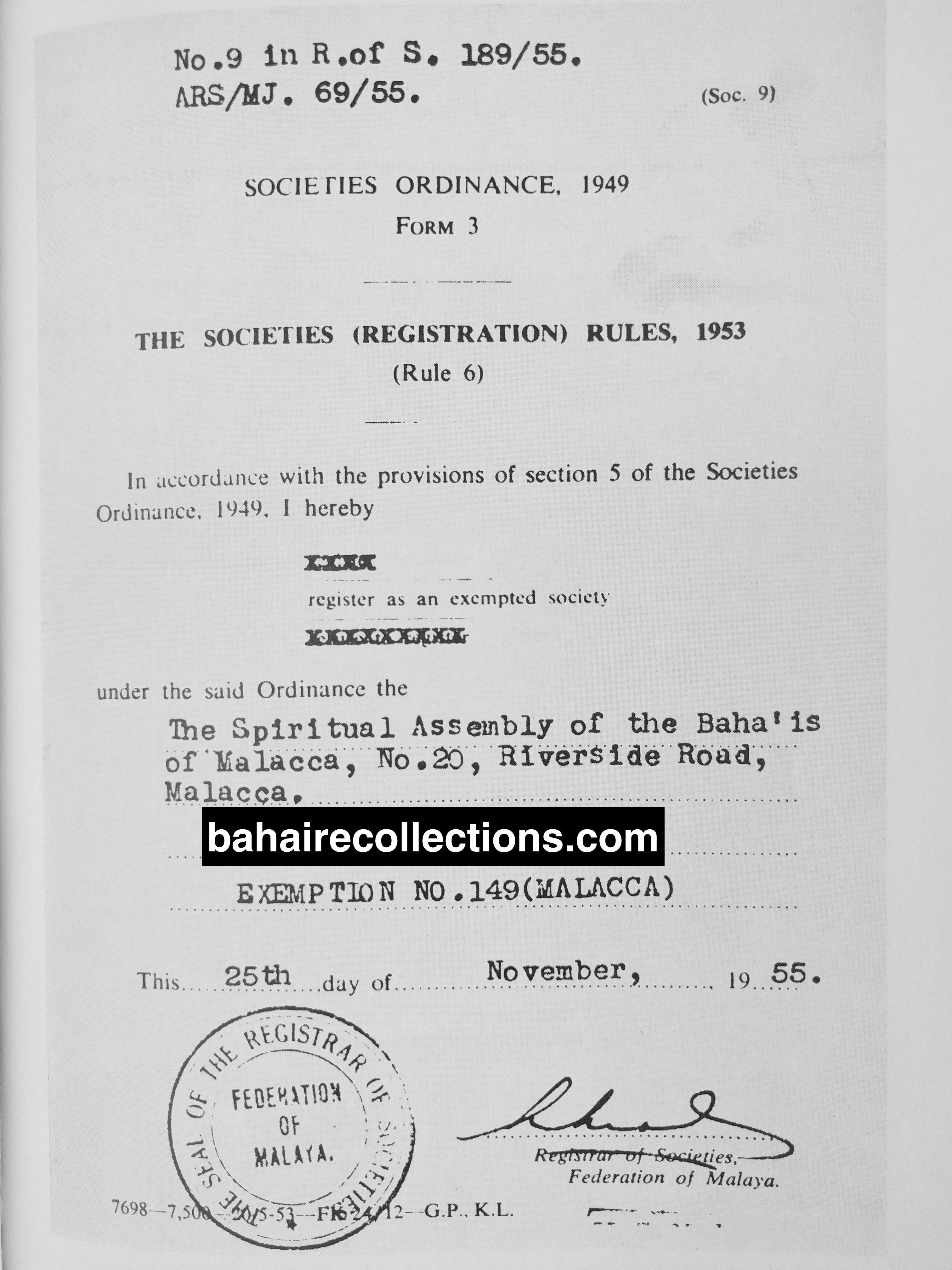
First Local Spiritual Assembly to be given official recognition by the British colonial government of the time.
Shirin Fozdar and her husband Dr. K. M. Fozdar took up temporary residence in Malacca town to deepen the believers. Later, they moved back to Singapore from where they made weekend trips to strengthen the community through conducting deepening classes and supplying Bahá’í books. From Singapore, they continued to communicate through letters in which they provided guidance on questions the Malacca believers raised.
The Malacca town community was afire immediately after the election of the Local Spiritual Assembly, with numerous activities taking place. These activities were reported in the Bahá’í News magazine published by the National Spiritual Assembly of the United States of America. So much so that in the early days, any reference to Malaya was invariably referring to the Malacca community, where numerous activities were taking place. Regular teaching activities and deepening classes were commonplace. A dynamic set of youth came into the Faith and for school students, Bahá’í Sunday classes were started and these were the first of its kind to have been initiated in the country. Again, the first Bahá’í songs for Malaya were composed in Malacca in 1958 by Mrs. Lena Saurajen, herself a music teacher who played them on her piano at Bahá’í functions.
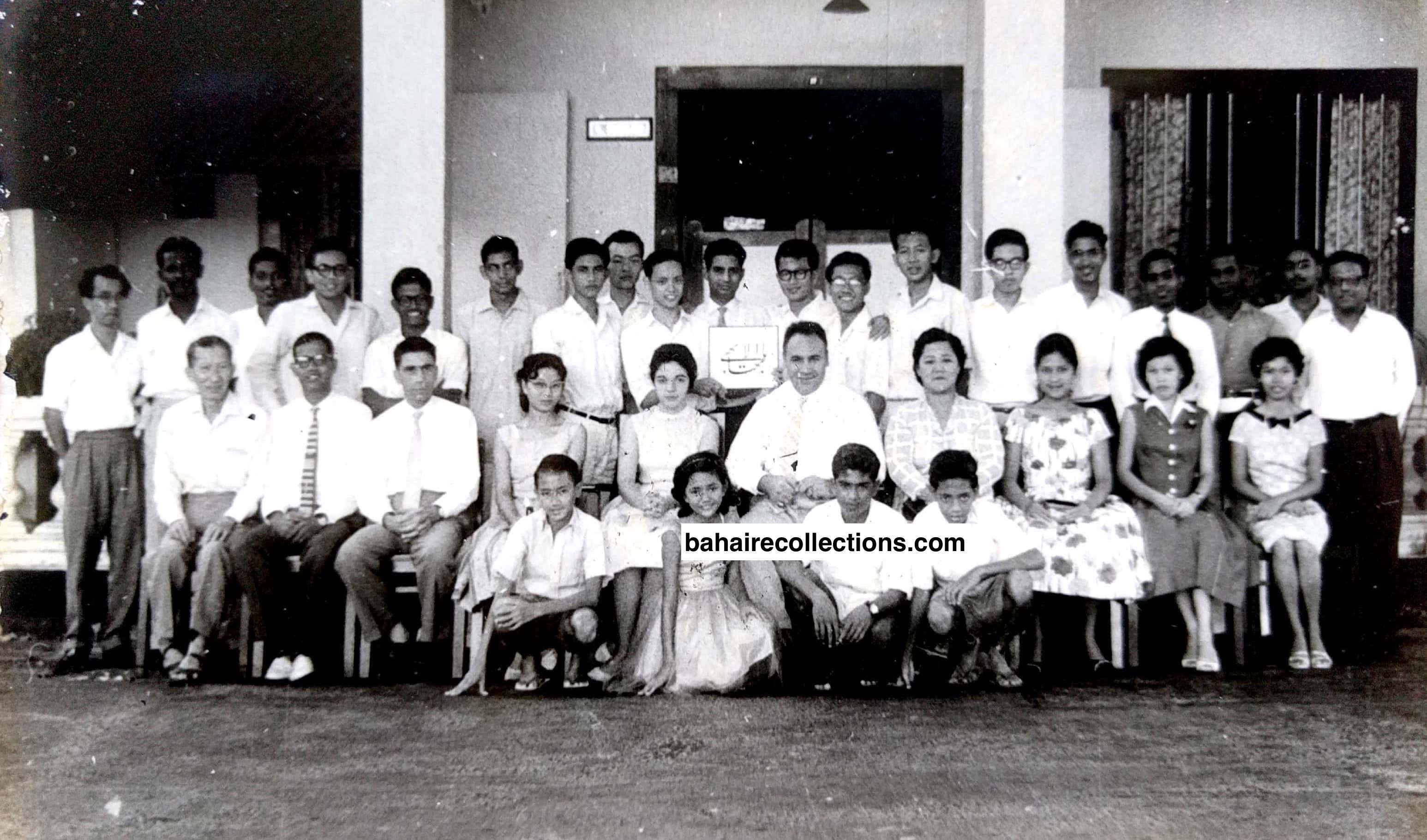
Dr. Muhájir and his wife Írán meeting believers of Malacca, July 1958. Seated (L-R) Yankee Leong, Anthony Louis, Eshraghian. To the left of Dr. Muhájir is Mrs. Lena Saurajen. Seated second from the right is Chan Suan Neo. Saurajen stands at the extreme right. Jami Subramaniam is standing fifth from left. Purushothman Nair is standing fifth from right.

Saurajen introducing Bahá’í greetings to the students of the Sunday classes, 1958.
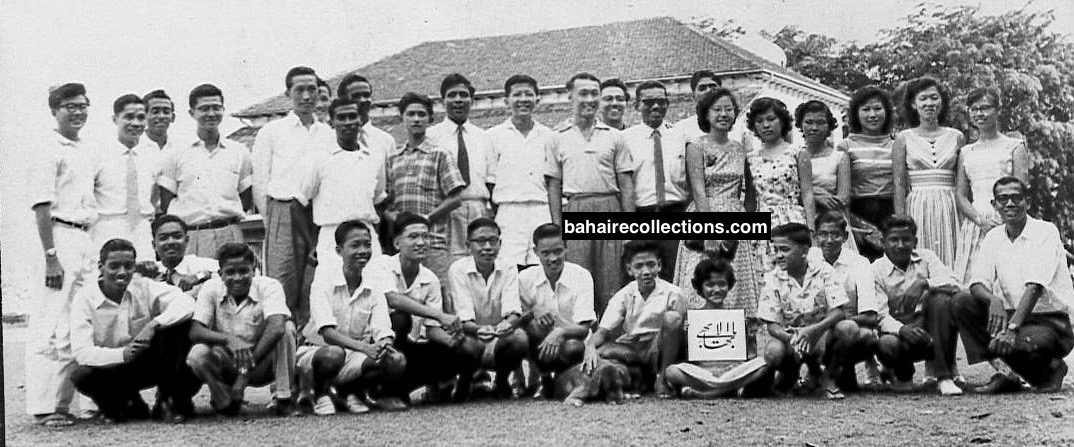
A gathering of adults and youth at the Boy Scout Headquarters, circa 1958. Kumara Das is in the middle with black necktie. Anthony Louis is squatting at the extreme right. Koh Ai Leen is standing at the extreme right. Lily is standing third from right, Raymond Peter stands eighth from the right with sunglasses. Leong Ho San is standing fifth from left, with M. Maniam standing in front of him. The three squatting from left are Pijush Kanti Paul, Tushar Kanti-Paul and Jami Subramaniam.
The first Youth Committee for Malaya was formed prior to July 1957 in Malacca. Bahai meetings took place in two places- residences of Saurajen and Leong Tat Chee. Saurajen’s house became the first official Bahá’í Centre, followed by the residence of Leong Tat Chee in 1961. Lending libraries were started. A Bahá’í way of life was fast evolving in many ways, such as fasting and observing of Holy Days. With constant reports of Malacca appearing in foreign Bahá’í magazines, several pioneers, traveling teachers, and Hands of the Cause of God were drawn to visit Malacca community. Hand of the Cause of God Mr. Shu’á’u’lláh ‘Alá’í visited in 1956 and later in 1960, while Dr. Muhájir visited first in December 1957 and made numerous follow up visits after that. Mr. Taráz’u’lláh Samandarí himself came in 1961 and again in 1966 and 1967. It was on the encouragement of Dr. Muhájir that Mr. Samandarí visited Malacca in 1961 as Dr. Muhájir had wanted Mr. Samandarí to witness for himself the great strides Malacca believers were making in this part of the world. When the Intercontinental Conference was held in Singapore on September 1958, an announcement was made that Malaya would be having its first Bahá’í wedding after the Conference and the excited Hands of the Cause Abu’l-Qásim Faizi and Agnes Alexander, as well as several foreign participants of the Conference, came to Malacca for the wedding which went to receive unprecedented press publicity for the Cause. This wedding of Mr. Eustace Anthony Fernandez to Miss Beatrice Philomena Monteiro on 5 October 1958 and their civil marriage registration on 3 October was the first of its kind in Malaya. Some years later in 1972, the Hand of the Cause of God Mr. Jalal Khazeh made a lighting visit to Malacca when he was attending the first National Convention in Singapore. Malacca was the only community he visited in Malaysia.
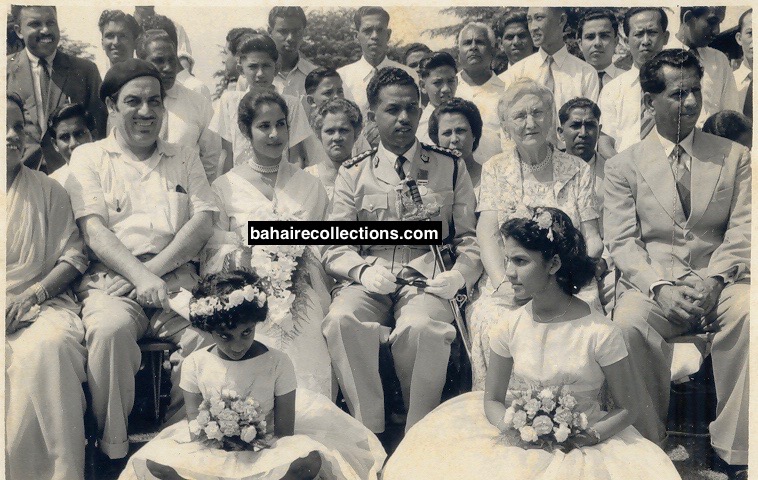
First Bahá’í wedding of Malaya. The bride Betty is flanked by Hand of the Cause of God Abu’l-Qásim Faizi while the groom Anthony is flanked by the Hand of the Cause of God Agnes Alexander.

A second visit by Hand of the Cause of God Mr. Shu’á’u’lláh ‘Alá’í to Malacca to Malacca, on 19 January 1960.

A special meeting of visitors to the Third Pan-Malayan Teaching Conference, 1961. (L-R) Mr. Samandarí, Mr. Ahmad Samimi, Mrs. Shirin Fozdar, Dr. Muhájir, Mr. Kishen Khemani.
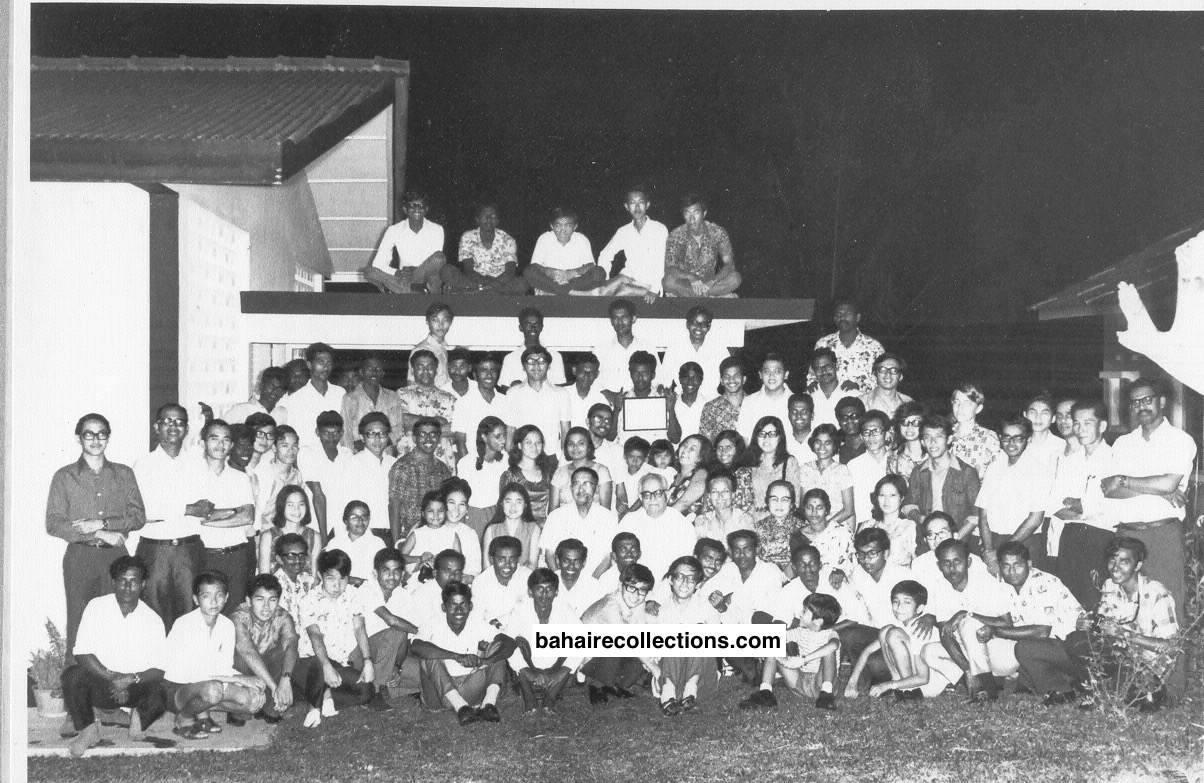
Hand of the Cause of God Mr. Jalal Khazeh making a lightning visit to Malacca in 1972, the only community he visited in Malaysia. He is seated in the center next to Leong Tat Chee in the Teaching Institute.
It was Dr. Muhájir who recognized the dynamism in the believers of Malacca and tapped their resourcefulness. The first community where the Bahá’í greeting ‘Alláh-u-Abhá’ was officially introduced was in Malacca by no less than Dr. Muhájir himself in 1957. He also called upon them to organize the first National Summer School which took place in December 1957, slightly over a month after the passing of the Guardian of the Faith in London. Some 50 believers from Malacca, Kuala Lumpur, Seremban and Singapore attended the first Summer School. On the last night of the Summer School, Dr. Muhájir called on some believers from various parts of Malaya and launched a Ten-Point Teaching Plan, in line with the requirements of the Ten-Year Plan goals which the beloved Guardian had initiated for the period 1953 to 1963. The entire Bahá’í world was deeply involved and committed to winning the goals with the strong encouragement coming from the Guardian, Hands of the Cause and the institutions. With the passing of the Guardian, there was a feverish passion by the entire Bahá’í world to win the goals of the Ten Year Crusade and to please the heart of the Guardian. Briefly, the plan that Dr. Muhájir introduced was in line with the Ten Year Plan goals and it touched upon the holding of regular inter-community get-togethers, obtaining burial grounds, acquiring land for local Bahá’í Centres, multiplication of localities, establishing Bahá’í groups, teaching aboriginal people, intensifying teaching activities in several ways, deepening by the avid reading of Bahá’í books, teaching women, importing books for children, and starting a Bahá’í correspondence course. Jeanne Frankel, an American pioneer who stopped over in Penang Island for a few months, was requested to initiate the correspondence course on the book ‘Paris Talks’, and that again was the first effort of its kind in Malaya. After the first Summer School, Jeanne and her mother Mrs. Margaret Kelly Bates who were Knights of Bahá’u’lláh for opening the Nicobar Islands remained in Malacca town and served in several parts of Malacca state. The Malacca believers continued to organize the summer schools almost every year right until the mid-1960s with Dr. Muhájir participating in most of them.

Dr. Muhájir seated at the extreme right at the Summer School, observing the proceedings.
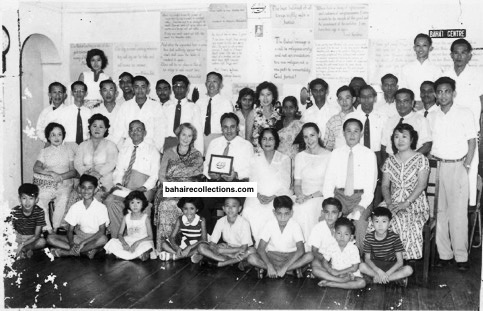
Teaching Conference taking place concurrently with the Summer School on 29 December 1957, where Dr. Muhájir launched a Ten-Point Program.
That was the first national plan that Dr. Muhájir gave the country, and this was followed over the years with several of his mind-boggling plans which he suggested to the Malaysian Bahá’í community until his passing in 1979. Dr. Muhájir very much came to be remembered as the architect of the Malaysian Bahá’í community with his loving guidance and the plans he proposed which were always accepted by the national institution. To a large extent, it was Malacca that became a springboard for the spread of the Faith to other parts of Malaya, which began with the Ten-Point Teaching Program that was launched at that first historic Summer School. Dr. Muhájir also encouraged believers to organize local and regional teaching conferences.

First Teaching Conference in July 1957. Seated second from the left is Yankee Leong, third from left is Lena Saurajen, fourth from the left is Shirin Fozdar, fifth from the left is Dr. K. M. Fozdar. Standing at the extreme right is Saurajen, and to his right are Tushar Kanti-Paul, Pijush Kanti Paul and Mirinal Kanti Paul. Kumara Das stands fifth from left, with Leong Tat Chee sixth from left.
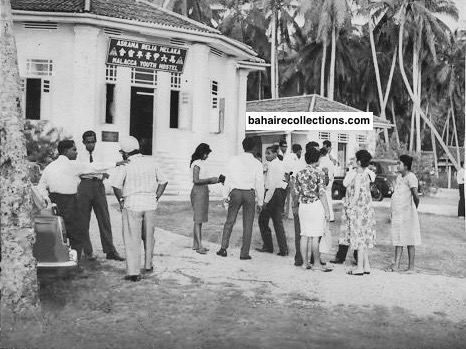
Malacca Youth Hostel in Pantai Kundor was a venue for gatherings. Sathiawan Singh with his back to the camera and with white turban talks to Tushar Kanti-Paul on the extreme left. Daisy Das is at the extreme right, and Betty Fernandez second from right.
On the encouragement of Dr. Muhájir, from 1957 the believers organized themselves into groups and travelled to each and every part within Malacca state and to most parts of Malaya to spread the Cause, establish communities, elect Local Assemblies and consolidate them. Dr. Muhájir himself joined them in some of these trips. Dr. Muhájir created in them a strong passion for teaching. The early believers of Malacca say that there was not a single day when they did not go out to teach. A day without any teaching activity was simply unthinkable for them. There were Bahá’ís whose habit was to go teaching daily as soon as they returned from work.
It was also the believers of Malacca who first took the Faith to the Asli (aboriginal) people. In 1957, they had already given the Faith to the Asli community of Kampung Jus in Malacca, and in 1959, the Local Spiritual Assembly of Simpang Bekok was formed, which was an Asli area. Dr. Muhájir himself had visited this community until 1960 to consolidate them.

First Asli village in Kampung Jus opened to the Faith since early 1957. This photo was taken by Anthony Louis in early 1958. Lena Saurajen and Saurajen are seated in the center.
On the encouragement of Dr. Muhájir, two Pan-Malayan Teaching Conferences were held in Malacca town in 1960 and 1961 where success stories were shared and new plans devised. The first Pan-Malayan Teaching Conference held on 8 May 1960 was the first national teaching conference for the country. These conferences provided the needed boost for the participants to surge ahead to bring victories for the Cause.
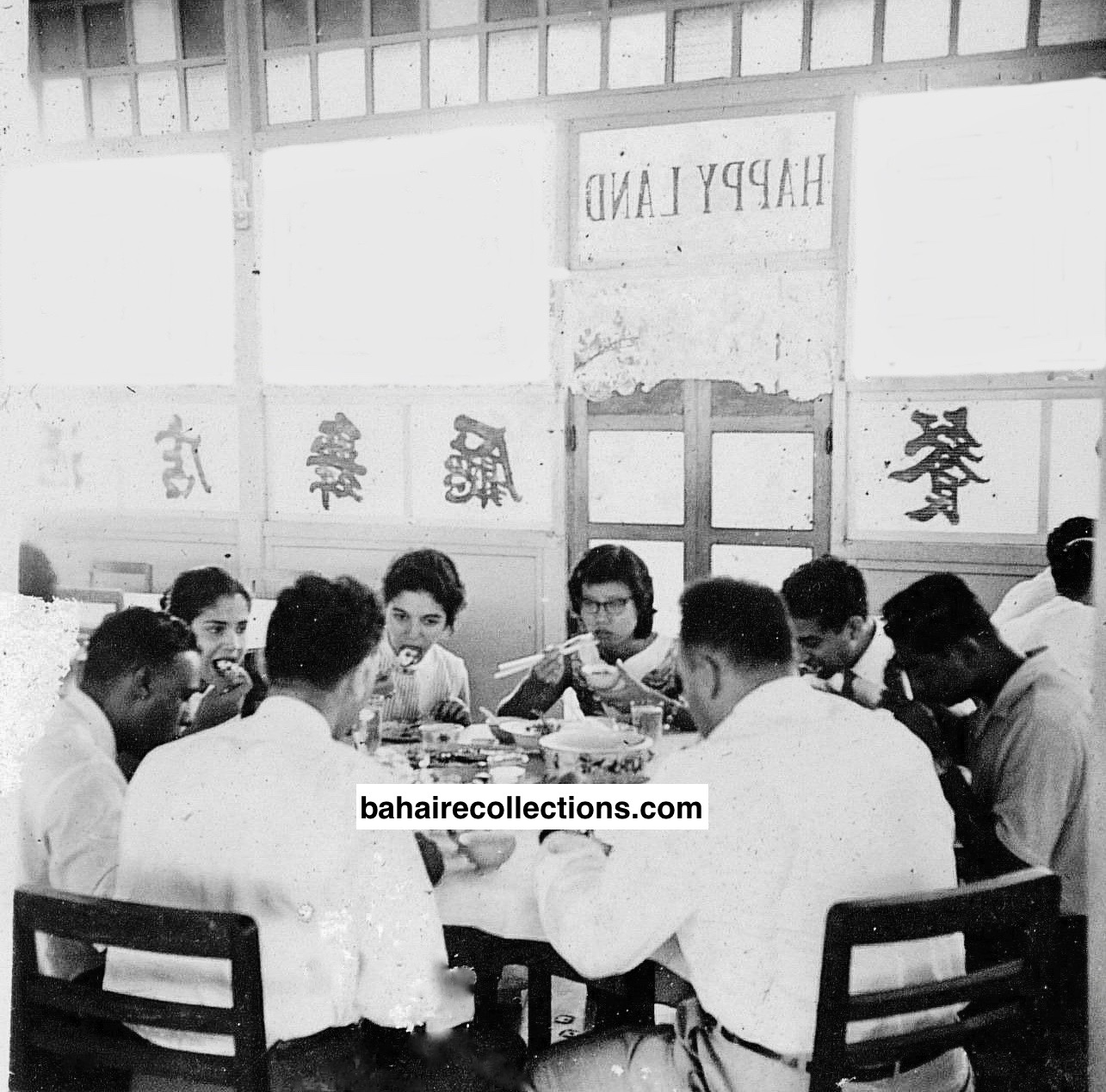
Dr. Muhájir having lunch with some of the participants of the First Pan-Malayan Teaching Conference, 1960. Seated second from left is Betty Fernandez, and on her left is Írán Muhájir.
In 1960, this community printed and sent out Naw-Rúz greeting cards for the first time in the then Malaya. The first Bahá’í burial ground for the country was acquired in Malacca in August 1960. Mr. T. K. Kannan of Malacca town became the first pioneer to the East Coast when he was posted as a teacher to Terengganu in 1960. Taking cognizance of the need of literature for the Tamil speaking segment, Mr. M. Palaniandy of Jasin and T. K. Kannan of Malacca, both of them being teachers, initiated the first Tamil translation of Bahá’í Writings in 1960. The first Translation Committee for the translation of Bahá’í materials into the Tamil language was established in Malacca in 1961, with S. Vasudevan Nair and Palaniandy as key translators. Malacca led in this area of service as well.
In 1960, the driving force and dynamism of the Malacca believers translated into producing the first Bahá’í news magazine which was also the first of its kind for Malaya. There was an article on the Bahá’í Faith by the Guardian, a few prayers, a few selections from the Holy Writings, an article on Loyalty to the Government, the National Anthem, the ‘Bahá’í Anthem’, Local News and International News, an article about Dr Esslemont, an editorial, the Bahá’í Calendar, Youth Corner, Pen Pal Section, Bahá’í Holy Days on which work should be suspended, a quiz on Bahá’í subjects, announcements, Bahá’í Writings on death, stories, a question and answer session and a calendar of events. The 40-page magazine was said to be highly inspiring to the Bahá’ís of Malacca.
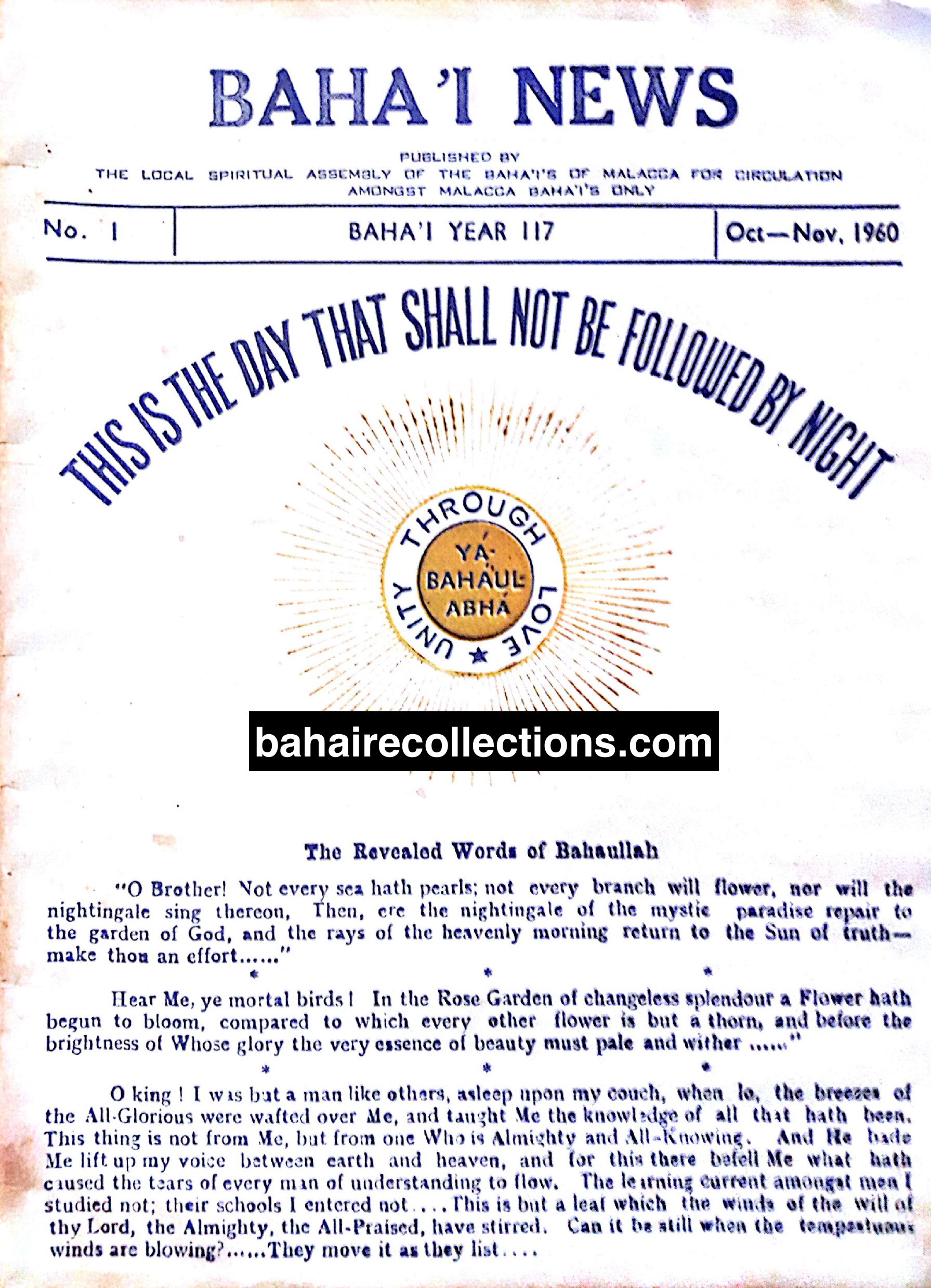
The first Bahá’í Magazine
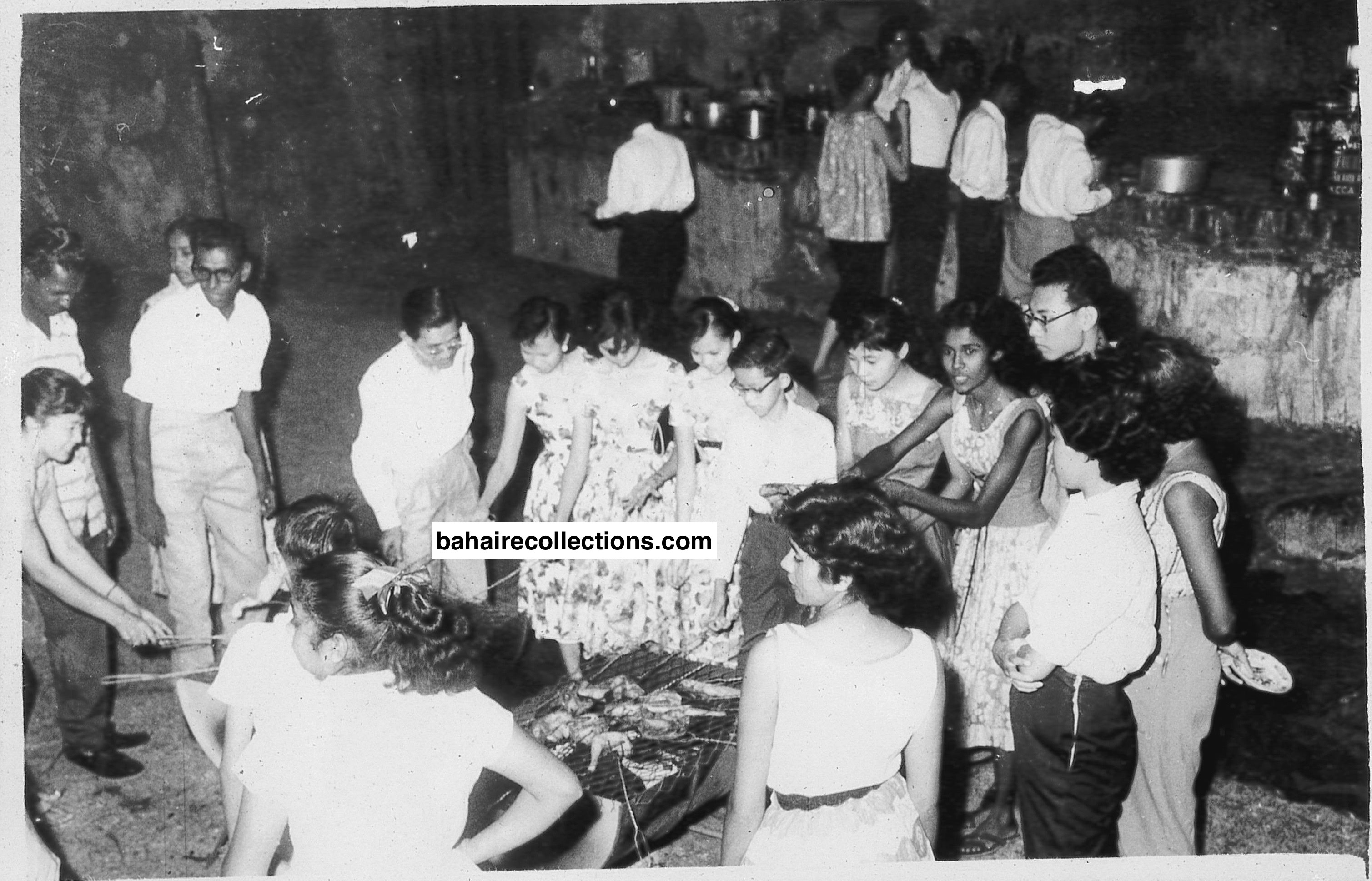
Naw-Rúz of 1960 celebrated with a barbeque in an open space on St. John’s Hill, Malacca.
Unfortunately, it was at the height of the spirit in Malacca when suddenly this community faced an unprecedented tempest caused by an individual. That individual had done so much for the Cause, but owing to what was termed a “boost of his ego”, wanted to have his ways. Dr. Muhájir and Auxiliary Board members in the region advised the believer but in vain. After much counsel and admonitions followed by warnings, the individual started to court his own following and split the community. Many believers were disheartened and some even became dormant. Finally, the Regional Spiritual Assembly of South East Asia removed the voting rights of the individual concerned. Providentially, following the crisis came unprecedented victories for the Cause. A new dynamism was ushered in with a hive of activities taking place through all the believers uniting around the Local Spiritual Assembly and the formation of several new committees to spearhead the further growth of the Faith. Malacca obtained its own burial ground; Naw-Rúz events came to be organized on a grand and most befitting manner; the Local Spiritual Assembly saw a new maturity and strength and firesides were held on a weekly basis. That crisis was seen as a blessing in disguise!

A grand Naw-Rúz celebration, 1962, a sign of strong victory after the unprecedented crisis. Naw-Rúz greeting cards were printed and sent out for the first time.
The Malacca Bahá’ís served with distinction at the national, regional and international levels as well. Malacca believers participated in all the conventions of the Regional Spiritual Assembly of South East Asia starting from its first election in 1957. This was an administrative body that existed before the election of individual National Assemblies in the respective countries. Leong Tat Chee, Saurajen and Tony Fernandez of Malacca and Yankee Leong of Seremban had served on this august body, while it was Leong Tat Chee who had served on the body continuously until its dissolution in 1963. At the First International Bahá’í Convention held for the election of the first Universal House of Justice in Haifa in 1963, Leong Tat Chee of Malacca was the only Malayan delegate. A group of the Malacca believers attended the First Bahá’í World Congress held in London in 1963 and returned with renewed enthusiasm and vigor to serve the Cause. At the First Bahá’í World Congress, it was Leong Tat Chee of Malacca who was the only Malayan delegate while Sathiawan Singh was the only Malayan believer from the Sikh background. Earlier in 1961 when Amatu’l-Bahá Rúhíyyih Khánum visited Malaya, she had requested Sathiawan Singh to attend the Congress with his turban on, which he did, and according to his own account, his appearance with a turban on was an attraction by itself at the Congress and on the London streets. Upon return to Malaya, he removed his turban.
The believers of Malacca town played an important role in the first National Convention for the election of the National Spiritual Assembly of the Bahá’ís of Malaysia. Leong Tat Chee was elected Chairman of the Convention and was elected on this first National Spiritual Assembly. In the same year, Dr. Muhájir appointed Leong Tat Chee as the first Auxiliary Board member for Malaysia. In 1965, S. Vasudevan Nair was elected Secretary of the National Spiritual Assembly, and at the encouragement of Dr. Muhájir, he left to go pioneering to Sri Lanka and then to India in May 1967. In the process, S. Vasudevan was the first pioneer of Malaysia to India.
Prior to the formation of the National Spiritual Assembly in 1964 and in the immediate years after that, the Malacca believers made up the lion’s share of the manpower for the national committees. The believers were in the organizing committees for Summer Schools, National Centre Building Committee, representatives to open virgin areas in the country, Teaching Conference Committee, Committee for the First Malacca Regional Teaching Conference, National Teaching Committee, Publications Sub-Committee, Publicity Committee, Deepening Committee, the editorial board of the ‘Malayan Bahá’í’ magazine, Sub-Committee for Consolidation; and the Editorial Board of ‘Berita Bahá’í’ – the first official newsletter of the National Assembly. The National Statistician and Book Manager also came from Malacca. In the 1970s, the Malacca community started its own Feast Newsletter at a time when most of the other communities had not yet attempted this.
By the mid-1960s, the Malacca town community was already well consolidated. The believers then arose to give a helping hand to other countries. In 1965, Leong Tat Chee and Yankee Leong undertook teaching trips to Hong Kong, Macau and Taiwan and thus Malacca became the first community in Malaysia to send travel teachers to these countries. In 1967, Leong Tat Chee went to Taiwan once again and then to Sri Lanka for travel teaching and in 1968, he went to Hong Kong, Macau and Taiwan again for teaching the Cause.
The trend continued in the 1970s a well. In 1970, Ng Ting Kee and Machakalai Chandran pioneered to Thailand while in 1972, S. T. Rajan pioneered to India and Hua Keng Tong to Australia. 1975 saw Goh Khye Seng pioneering to Hong Kong and Taiwan while in 1976, Govindan Gurusamy pioneered to Thailand. In 1977, Tan Choo Tiong left for Taiwan to travel teach and in 1978, Jayabalan Krishnan left for Thailand and Manmohan Singh for Sri Lanka.
Malacca holds the distinction of erecting in 1965 the first national teaching institute in the country which was also the first of its kind in South East Asia. Upon completion, this building hosted numerous local and regional activities of various nature such as weekend deepening, courses for pioneers, courses for the orang Asli people and other ethnic groups. Most of these early activities were also the first efforts in the country. In 1975, the first Winter School for Tamil-speaking friends in the country was held at the Institute.
Official opening of the National Teaching Institute, first of its kind in South East Asia, 1965.
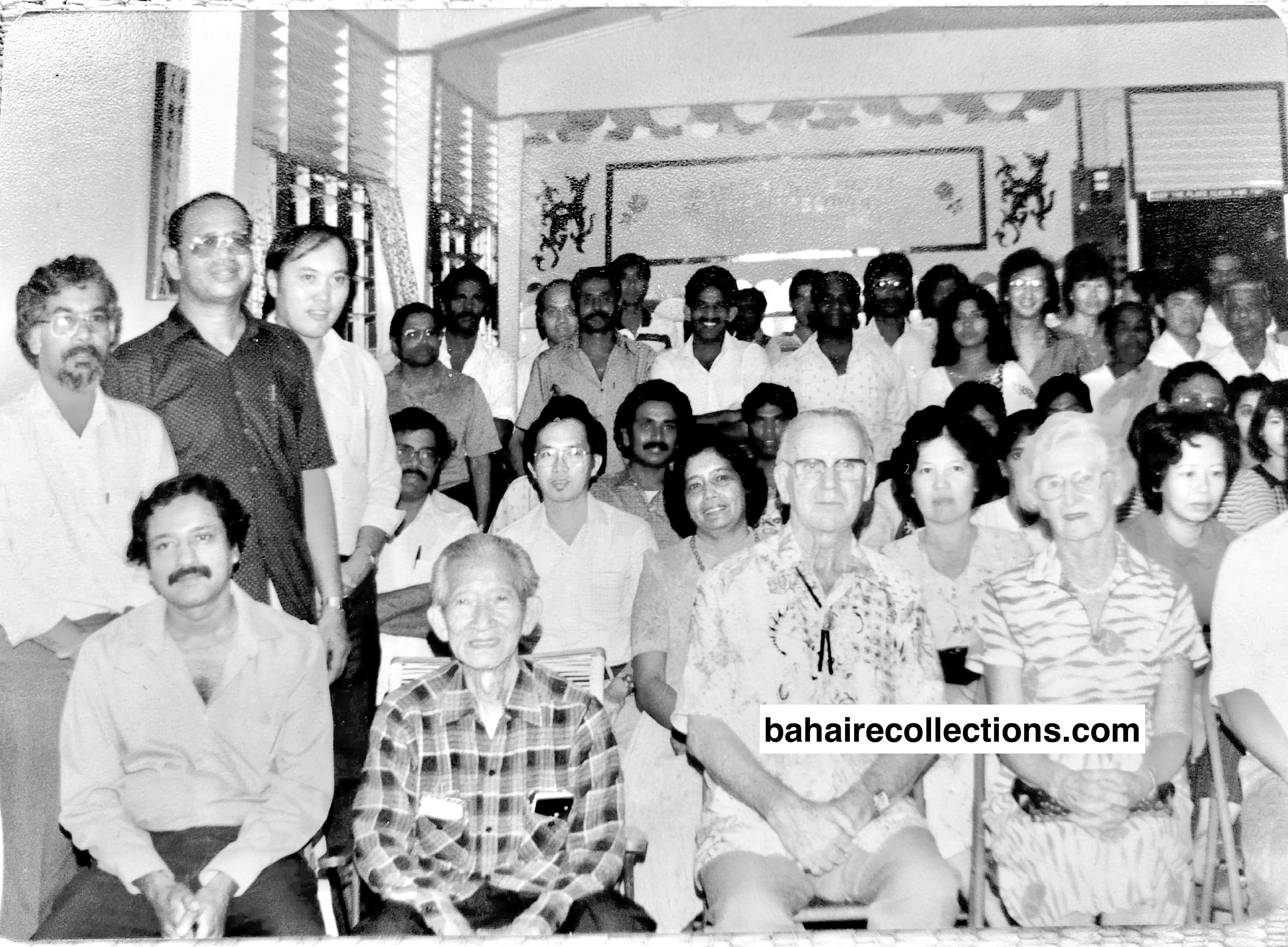
The Teaching Institute served the local, regional and national events. Here is seen Hand of the Cause of God Mr. Collis Featherstone and his wife Madge at the Intercalary Days celebrations at the Institute, 1985. Seated on the extreme left is Purushothman Nair, with Yankee Leong next to him. Standing (L-R) are Shanmugam (Muar), Anthony Louis (Malacca) and Wong Maniam (Johor Bahru).

The next generation. (Photo of 1984) Sitting L-R: Amelia Louis, Mary Neo, Shahnaz Das, Narinderjit Kaur, Irene Leong. Standing L-R: Manmohan Singh, Suresh Pillay, Dinesh Kumar(currently serving as ITC Counselor), Lum Weng Kuan, Anthony, Alex, Anthony Das, Benny Soon and Joe Ganapathy. Back Row L-R: Gurjit Singh, Sewak Singh, Anthony Francis.
JASIN
Many believers in the state of Malacca kept relocating to various parts of the state or country stemming from job promotions or transfers. Upon the establishment of the Local Spiritual Assembly of Malacca town in 1955, efforts were made to take the Faith to all parts of Malacca state such as to Jasin district, Alor Gajah district and its sub-district of Masjid Tanah. In some instances, the Local Spiritual Assemblies of Malacca Town, Jasin, and Masjid Tanah had their own victories, but in most cases, they teamed up and worked in unison, almost as a single unit.
Jasin town is within the Jasin District in the state of Malacca. In 1955, Tushar Kanti-Paul of Malacca town went to Jasin as the first home front pioneer in Malaya. Among those who accepted the Faith in Jasin were Arumugam Ramanan (headmaster of a Tamil school and first to accept the Faith there), Anthony Fernandez (a Police Inspector), Betty Monteiro (a Kirkby trained teacher), Kit Yin Kiang (school clerk), Raymond Peter (a Health Inspector whose nature of job resulted in him being transferred regularly), Surinder Singh (businessman) and Arthur Knight (Police Officer). A Local Spiritual Assembly for Jasin was elected in 1958.
It was in 1957 that the first large scale teaching efforts in the rubber plantations were initiated by the believers of Jasin town. Tony Fernandez and Leong Ho Chiew took Raymond Peter along to translate their talks into Tamil. Raymond was an enquirer at that time. Early 1958, he accepted the Faith. Mass teaching started in the rubber plantations in 1960 and Raymond was the first to go around to most of the estates in the state to teach the Faith.
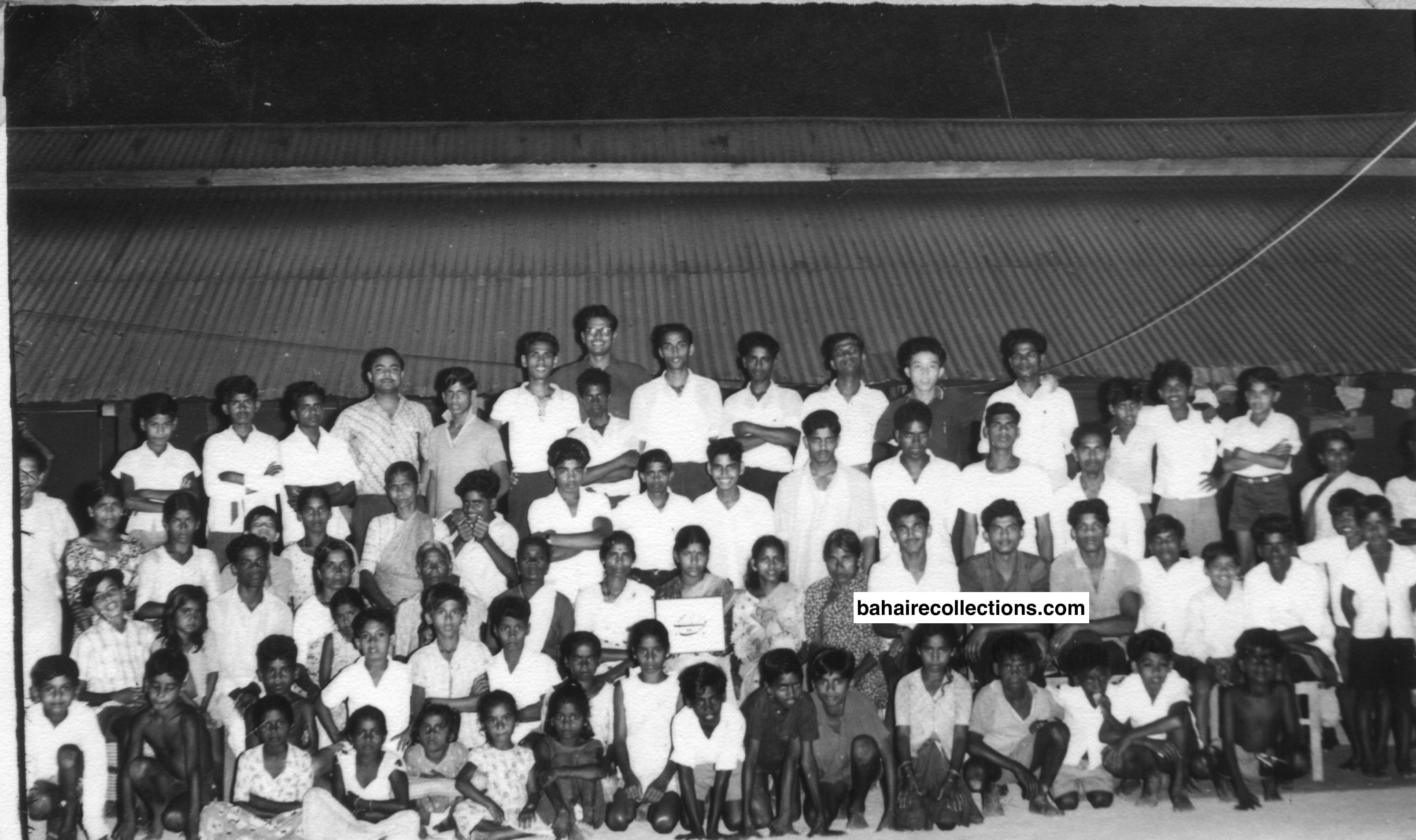
Serkam Estate, 1962. Back row- fourth from left is Tushar Kanti-Paul and standing tallest in the middle is S. Vasudevan.
Jasin community holds the distinction of being the first community in Malaya to start regular children’s classes in 1962 when Inparaju “Inbum” Chinniah and his wife Lily started residing there. Kit Yin Kiang of Jasin pioneered to Taiwan as Malaysia’s first pioneer in 1967. The Jasin Secondary School Bahá’í Society formed in 1968 was the first Bahá’í Society to be formed in a secondary school in the country.
In 1965, Inbum Chinniah who was residing in Jasin was elected as Treasurer of the National Spiritual Assembly and in 1967 became Secretary and moved to Kuala Lumpur in 1969. In 1972, he went to Tanzania on a six-month pioneering trip and upon return was appointed Auxiliary Board Member and in 1977 appointed to the Continental Board of Counsellors. In 1968, Raymond Peter was elected to the national institution and at the end of 1969, left with his wife Joan to pioneer to Sri Lanka.
ALOR GAJAH
The first Bahá’í Centre to be erected in the country was that of Alor Gajah town in February 1961. Dr. Muhájir himself was present at its inauguration. However, the Bahá’í Centre faced some complications over documentations and had to be abandoned later.
Masjid Tanah is the sub-district of Alor Gajah and the key believer here was it was Inbum Chinniah who was headmaster of the English School there. He accepted the Faith in 1957. But he and his wife Lily moved to Jasin in 1962. S. Sathasivam, a teacher who accepted the Faith in 1965, arose to fill the vacuum and moved to Jasin. In 1965, Dr. Muhájir gave some children’s class materials to Sathasivam, who later devoted himself to the development of children’s classes in Malacca state. He conducted weekly children classes in some 18 estates from 1965 through 1974 in the entire state of Malacca, supported by his family members. Sathasivam’s Teachers’ Transit Quarters served well as a place for several gatherings for believers from Masjid Tanah and the surroundings.

Children’s class in Masjid Tanah. S. Sathasivam is in the center with hands around his knee.
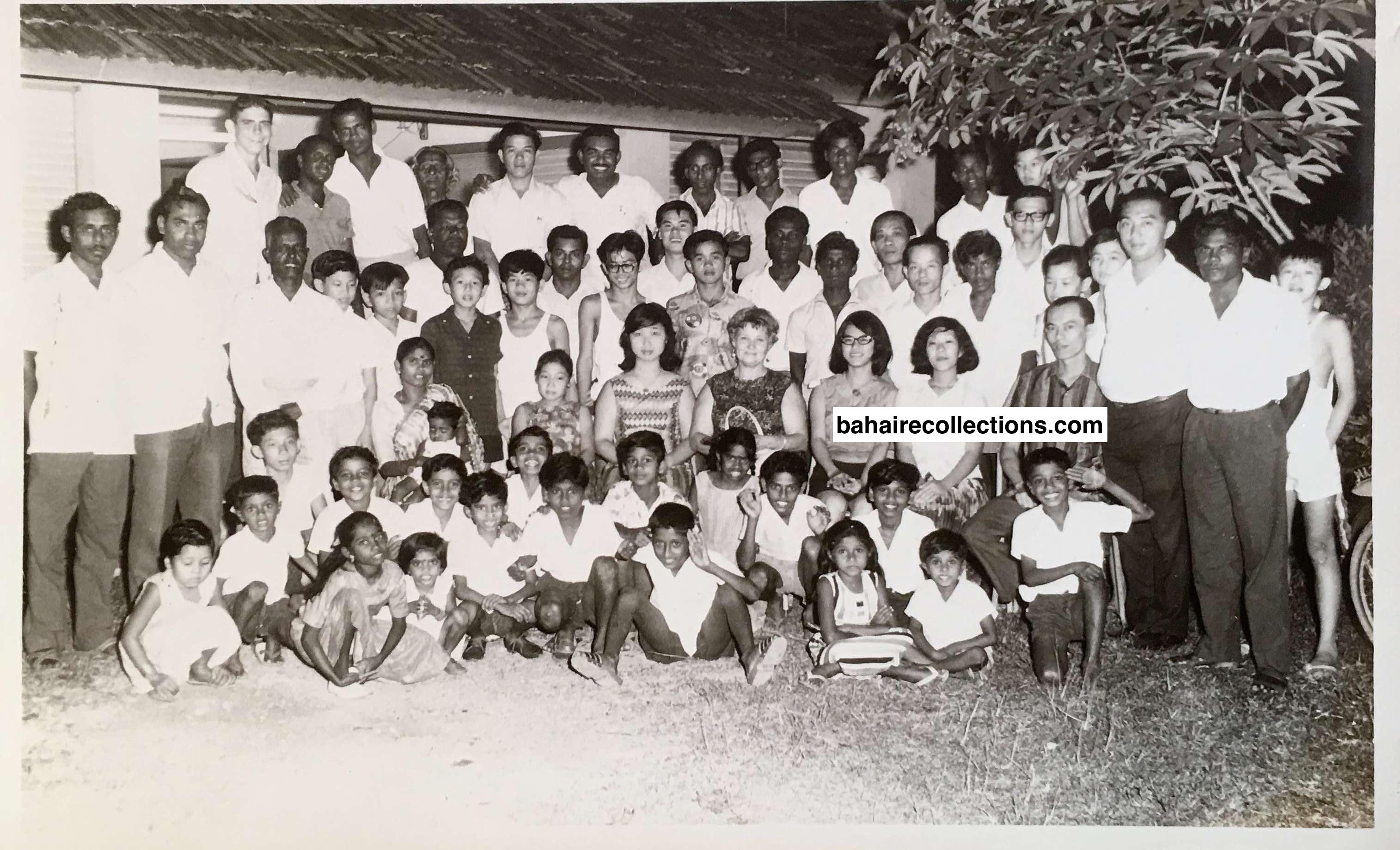
S. Sathasivam, standing at the extreme left and Mrs. Orpha Daugherty seated in the center, with believers from the Masjid Tanah region, at his Teachers’ Transit Quarters, 1966. Standing at the center at the back row is Raymond Peter.
Masjid Tanah was one of the areas where there was a large presence of ethnic Chinese. As a predominantly Chinese area, it was chosen for organised Chinese teaching. Soon this ‘difficult area’ became a centre for mass conversion. In 1965, there were 28 Local Spiritual Assemblies in the Masjid Tanah area with the meetings of the Local Spiritual Assembly conducted in the Chinese language. In October 1966, a successful Chinese Conference was held in Masjid Tanah.
The first mass enrollment of the Chinese people in the history of the Faith in the country took place when 150 people accepted the Faith during a talk by Hand of the Cause of God Mr. Taráz’u’lláh Samandarí in 1966 at the Sekolah Menengah Ghaffar Baba in Masjid Tanah. Later, Machap Umboo village had a strong concentration of Chinese believers who were in the forefront of activities.

The youths of Machap Umboo. Goh Khye Seng is seated in the center, and Clement Tan stands at the extreme left in the middle row.
In 1970, Bhaskaran Sangaran Nair who had been transferred from Malacca town to Alor Gajah town was elected to the national institution and in 1972 left for Cameroons in Africa for a six month period to pioneer. He returned and took his wife and children along in 1973, and thus they became the first as a family to pioneer from Malaysia.
MALACCA STATE AS A WHOLE
It is very clear that the Malacca town Bahá’í community took the lead, supported by communities from other districts, primarily Jasin and Masjid Tanah, and won victories for the Cause in several ways. Whenever references were made to Malaya in the early 1950s, it was Malacca that was invariably in the limelight in international statistical reports and magazines. Much of the resources needed at the national level such as national committees as well as national and regional events held in the Malacca area came from among these communities in Malacca state.
In the course of the first ten years of the founding of the Faith in Malacca, this community sent out a sizeable portion of travel teachers to several parts of the country and pioneers abroad. Many are those who transferred to other parts of the country or overseas where they continued to perform indelible services for the Cause.
Among the other visitors who were attracted to Malacca state at different times and gave all the encouragement were Mr. K. Payman pioneering in Indonesia, Dr. John Fozdar, a Knight of Bahá’u’lláh for Borneo, Mr. Jamshed Fozdar pioneering in Vietnam, Mr. Ahmad Samimi pioneering in Indonesia, Mr. Kamran Samimi pioneering Indonesia, Mrs. Marjorie Lighthall pioneering to Brunei, Auxiliary Board member Mr. Kishen Khemani pioneering in Singapore, Dr. Eshraghian who pioneering in Singapore, Mrs. George Lee from Singapore, William Walter Smits from the USA, Professor Avaregan from Italy, Dr. S. I. Dean and his wife Belle from the USA. But Dr. Muhájir continued to be the prime mover of the hearts of the believers through his constant visits.
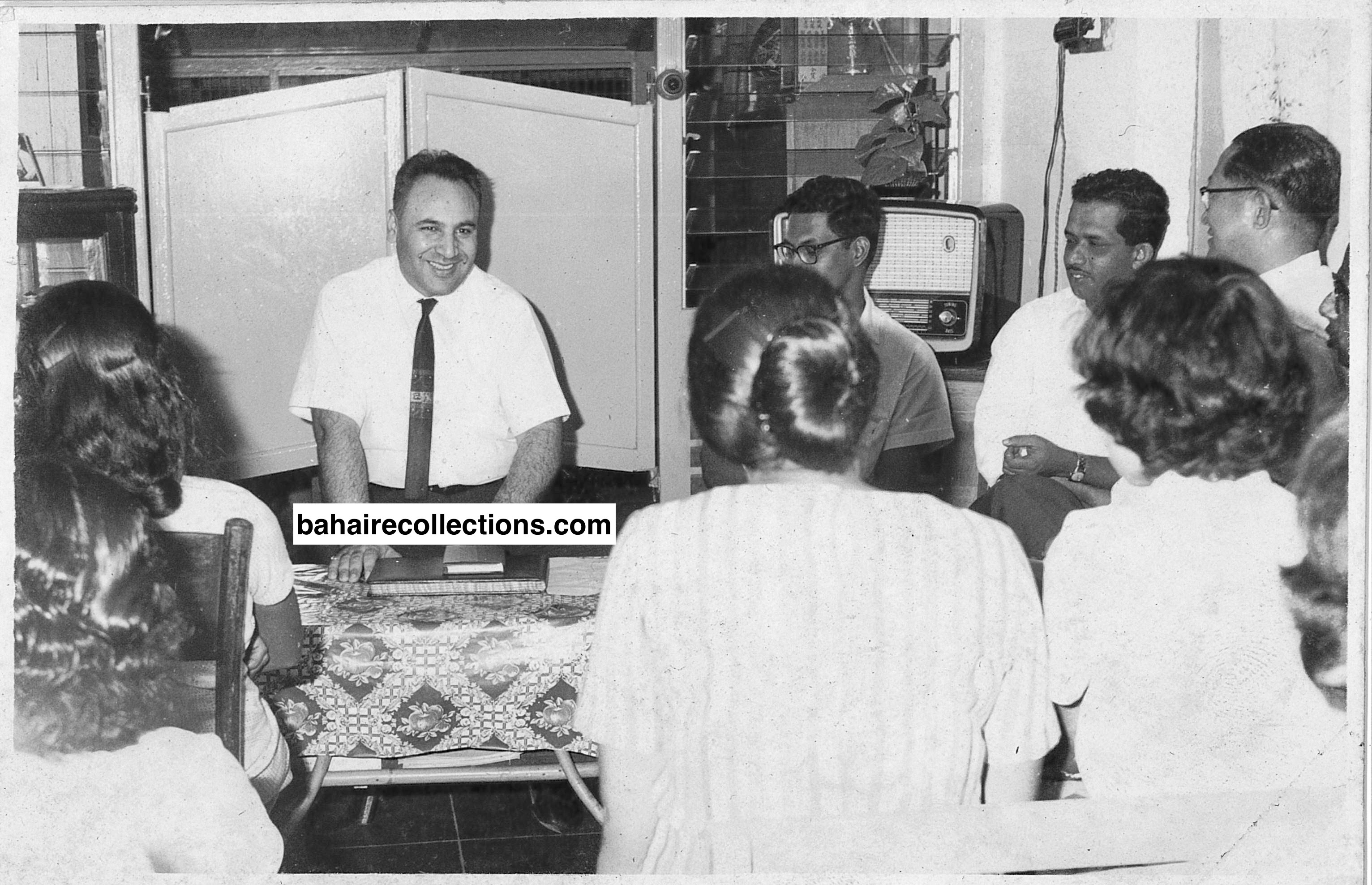 Dr. Muhájir meets the Malacca community in February 1963, to make the final push to win the remaining goals of the Ten-Year Crusade. To his left are S. Bhaskaran (partly hidden), Tony Fernandez and Leong Tat Chee. Dr. Muhájir was the driving force in the early days in Malacca, and it was from Malacca that he spread his wings over other communities in Malaysia.
Dr. Muhájir meets the Malacca community in February 1963, to make the final push to win the remaining goals of the Ten-Year Crusade. To his left are S. Bhaskaran (partly hidden), Tony Fernandez and Leong Tat Chee. Dr. Muhájir was the driving force in the early days in Malacca, and it was from Malacca that he spread his wings over other communities in Malaysia.
The first ten years of the Faith in Malacca were concurrent with the Ten-Year Crusade. With Malacca showing early signs of promise, this community drew the attention of several visitors, pioneers and members of institutions such as Hands of the Cause of God, Auxiliary Board members and members of the Regional Spiritual Assembly of South East Asia who rushed to this vibrant community to tap its resources and provide assistance and support. Foremost in the minds of these visitors was to stimulate the Malacca believers to achieve the goals of the Ten-Year Crusade both within Malacca and in Malaya. Thus, the spirit of the Ten-Year Crusade animated and moved them to scale heights of achievement.
The early Bahá’ís in Malacca often spoke of the ‘fantastic spirit’ and the ‘magical spirit’ in their community. To them, this was something that “just could not be explained.” There are a number of factors as to why this spirit was prevalent. In the first place, the Bahá’í community was a small one, and therefore the Bahá’ís became very closely knit. The teachings and principles, as well as the administrative system of the Faith, inspired the believers. Many of the early believers in Malacca were fluent in English and could benefit from talks and Bahá’í literature available in the English language. Whenever the Bahá’ís gathered, they were able to feel a new spirit that was absent in the wider society. The deepening classes, Bahá’í Holy Days, Feasts and other gatherings are reported to have had a loving and electrifying atmosphere. Malacca truly holds a unique place in the history of the Faith in this country.
This community produced several God-intoxicated servants, who in their own ways shone as standard-bearers of the Faith. Leong Tat Chee himself set an example by contributing his house to the National Spiritual Assembly during the National Convention of 1967. He was the first in the country to announce the donation of his house to the national institution, immediately followed by Yankee Leong who also announced the donation of his house in Seremban to the national institution.
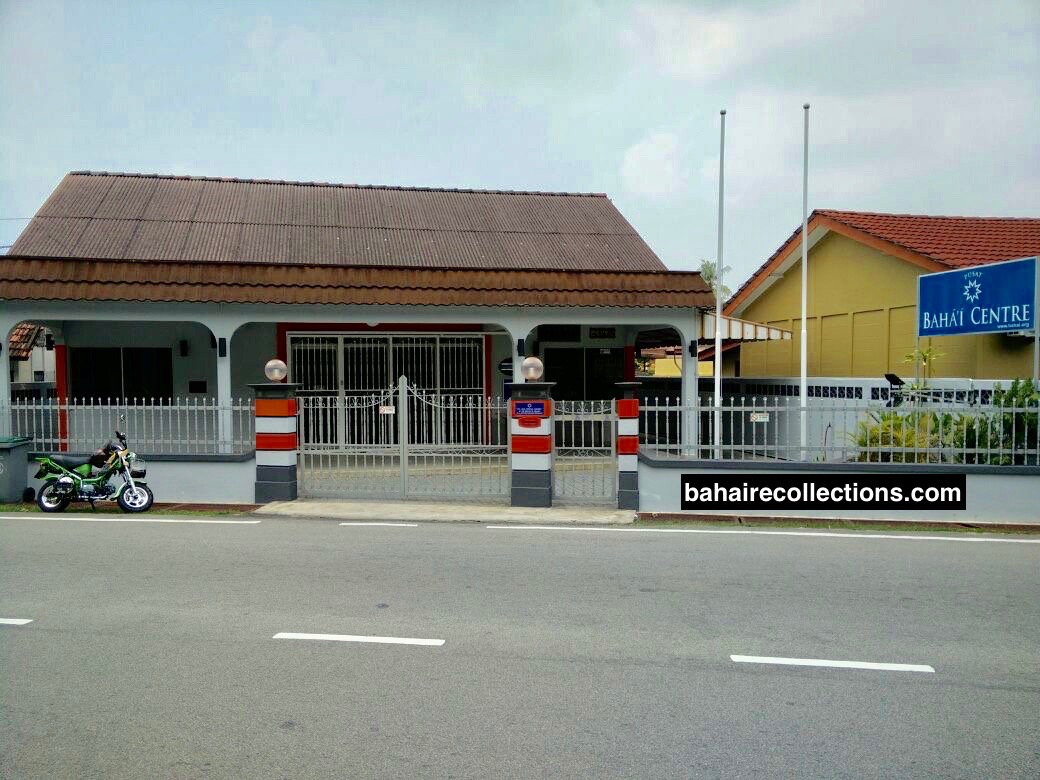
The house of Leong Tat Chee as it appears today, with impressive renovation done by Errol Seow who accepted the Faith in Malacca in 1958.
The selfless, strenuous and sacrificial services the early believers rendered to the Faith, the heroism with which they defended the Faith during a period of crisis, the firmness they strikingly demonstrated in obedience to the Covenant, the passion and commitment with which they carried out the tasks assigned, and the victories won in manifold areas of the Faith are among the badges of pride that this community wears badges that whose luster time can never dim. Thus, Malacca was truly the earliest place of several Dawnings!
The Book DAWNINGS
What has been written above of the pre-eminent community is only the tip of the ice-berg. A comprehensive book on this premier community of West Malaysia has been published by the Bahá’í Publishing Trust of Malaysia under the title of DAWNINGS. This book of 451 pages carries absorbing information of the early Malayan / Malaysian believers and contains 180 photographs rarely seen or not published earlier. The book is copiously footnoted with references.
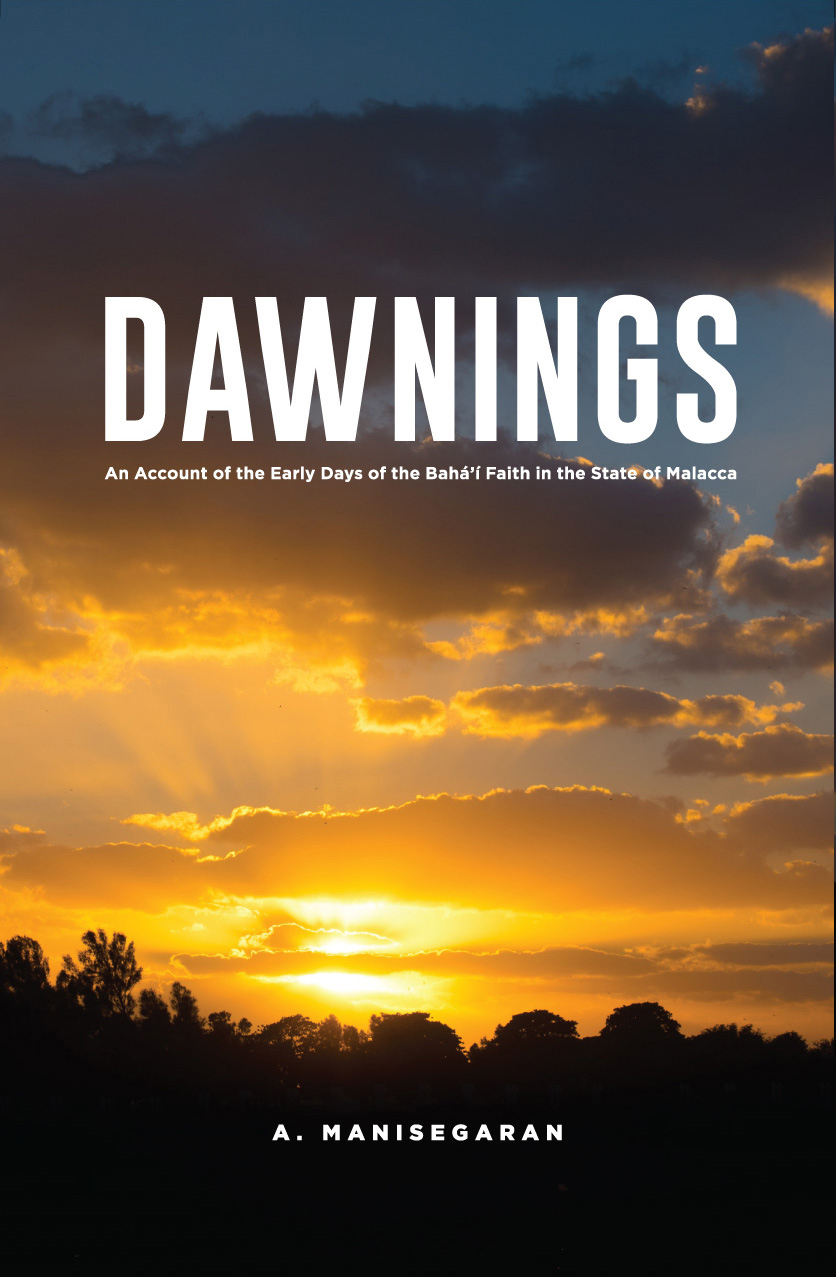
The book is available online in Amazon Kindle:
A. Manisegaran
31 July, 2018
Copyright@bahairecollections.com
7 thoughts on “A PREMIER COMMUNITY OF A RARE KIND”
Dear Mani
Thank You for this very informative and factual material of the birth and growth of the Faith in Malacca. I can recollect some of the prominent Bahais mentioned here. I now tempted to certainly order one copy of your book Dawnings.
Thanks again for your painstaking research and presesrving them in writing for posterity.
God bless.!
Audi Narasingam
Muar
Malaysia
Dear Manisegaran,
I am responding from a distantly and remotely placed pioneering field- Dili, Timor Leste.
What a way of starting my day! What an inspiring read about the early days of Malacca. Just this write up itself had me feeling goose bumps all over! This is the kind of spirit needed for those like me out in the teaching field.
The write up has been done so skillfully that I Just cant wait to get my hands on the book itself. I am more than certain it is going to be “unputdownable” if I may use this word that I have coined.
The write up had me drifting back to those days…with so many mentions of the early believers and their early activities carried out with so much passion, commitment and feelings. What a wonderful time it would have been if I had been born then and become part of those crusaders, and join the rank of those who gave “birth” to the so many firsts!
Thank you Mani for such an endearing and inspiring write up.
Keep up this superb and wonderful service..
Regards
Gunendra
Dili, Timur Leste
Many thanks dear Manisegaran for this remarkable story. It well portrays an important era of the early development of the Faith in Malacca. I have read with much interest. It contains interesting stories and rare pictures which I had not seen before. I have my own connection with Malacca.
No doubt this story will leave for posterity unforgettable traces of the glorious history of the Faith in Malacca, and by extension Malaysia as well.
Thanks again, and do keep writing more and more.
Dr. Firaydun Mithaq
Chieng Mai
Thailand
My dear Mani,
I just finished your write up on the progress of the Faith in Malacca in the early days. After your write up on the early history of Malacca, I could not wait to read the book DAWNINGS, it’s just too incredible and too tempting. On hearing that the books were selling fast, I bought 17 copies for my family. I was on time. A few days later I was told all copies have been sold off.
Your write up is a true history in detail, as always. It took me down the memory lane and your brought to the fore and reminded some of the events that I had forgotten. I couldn’t even remember some of your descriptions of all that took place in Malacca. But you have captured them.Full of facts with authentic backup of footnotes, photos and other references. I come from Malacca and so I can vouch for the accuracy and authenticity of the book. Surprisingly, and not coming from Malacca, and having settled abroad, you are able to write on that community. Simply amazing! It is a gift that God has endowed upon you. I am sure you must have spent endless days on research on the early history of Malacca.
The book is written with excellent and in a compelling style. I was simply absorbed into the book. It is the ease with which you write and the style you employ that makes any difficult matter so interesting. I was a teacher and I can say that you certainly have a good command of the English language to captivate the readers.
I once again wish to thank you for writing earlier books on my late husband and father. Thank you very very much my dear Mani for everything!
Believe me my dear Mani. Only you are able to do this great job. I really admire tremendously, my dear Mani.You are one of its kind.Nobody can come close to you! These are not mere emotional words from me. I have been reading all your books and each and every posting in your Bahai Recollections blog. This is indeed a gift from God, and I sincerely pray for Bahaullah to give you long life, sharp mind and good health to enable you to pen more and more books to be preserved for the accurate history to be recorded for posterity.
My prayers is for Bahaullah to give you good health and long life to write more books.
Lily Chinniah
Kuala Lumpur
Malaysia
It was certainly a very interesting time, exciting and appealing to the early believers who recognized the truth of the Baha’i teachings and their application in this day and age.
When our father, with the agreement of mother, decided to offer their family home as an endowment to the Faith, they consulted with the seven of us children who had, by that time, become believers in their own right. We all consented, without any reservation, that it was a humble and magnanimous act in good faith.
That was it, done and straightforward with no arguments between our parents and us, their children. Looking back now, I am not surprised that it happened so naturally, without any fuss and further discussion on the matter.
Today of course there is a Baha’i Centre in Malacca, no more our family home, but it is there to serve the community for posterity!
Leong Ho San
Wollongong
AUSTRALIA
Dear Mani
Very interesting and deeply informative, as in all your write ups!
This story is more than convincing that Malacca was certainly a premier community in those days, going by the track record and the first time efforts for the Faith in the country. It is news to me that Malacca has produced the first ITC Counselor. This is yet one more feather in the cap for Malaysia.
I am also associated with Malacca in my own ways in the late 1960s. I am able to travel back in time as I read some of the events. Nostalgic and mesmerizing to say the least!
I am already absorbed into a quick sand. I just cant wait for the book. I have to phone up the Bahai Bookshop-immediately to get my copy mailed out to the USA where I live now.
C. Kanagaratnam
Arizona
USA
Dear Mani,
Reading your story, I immediately got hold of the book DAWNINGS. At the outset I must admit that the book provided historical records with hard proof. With ample photographs, with dates and reference to the accounts made and where possible quotes from people referred to, the book leaves no room for doubt. The book stands in stark contrast to mere stories which tend to be colored by the writer’s prejudice. Yours is history based on true facts. I am from Malacca and I can vouch for the authenticity of the book. Congratulations on a great job done!
I must wake up more people to go through these wonderfully written pages so that their contents may fire their energies with constructive activities. I recall the echo of the Counselor who said “Become the master of your present circumstances, not its slave.” In this book, I see how the characters act out with that spirit, of which many of us were ignorant of.
The facts and figures presented gives hard proof, of which one is badly in need of when talking about the Faith to any enquirers. I see how the Faith grows through many phases of growth. At this time, you have made this valuable contribution to act like a spring to sprint us back to action. You have renewed my spirit by acquainting me with the spirit of those days which is not bound to return in the same form.
Kudos to you Manisegaran!
Chandrasekaran
Ampang Jaya
Malaysia